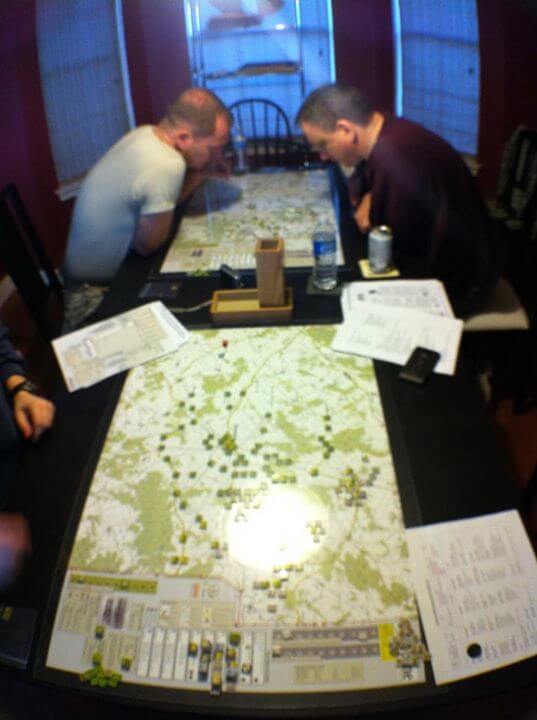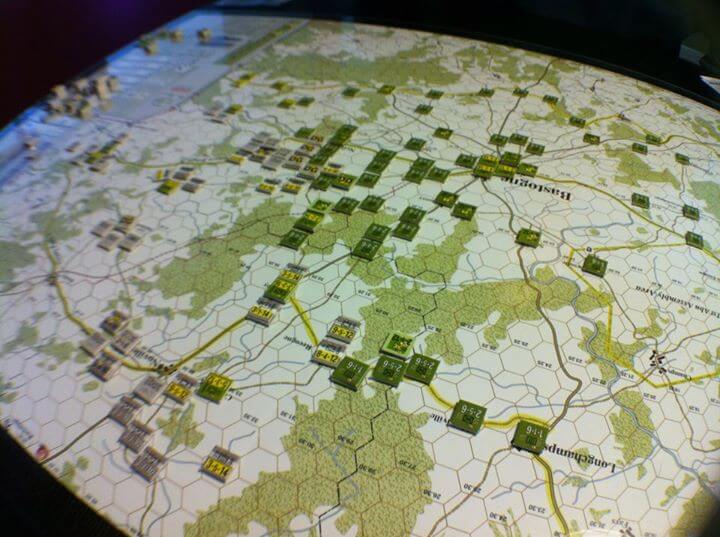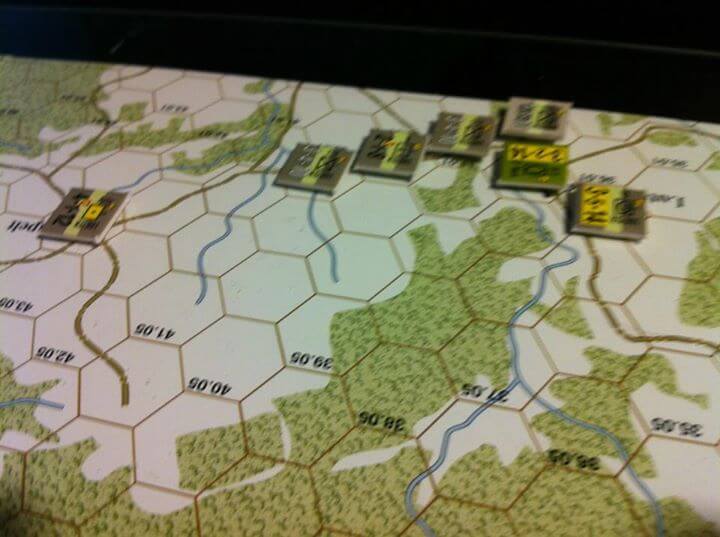Recap:
The second in an occasional series of games played by 4 guys who share a common interest in historical conflict simulations.
This weekend we played Bastogne. Another SCS title. Our games are chosen around a number of factors, firstly era of interest, then play ability, opportunity to complete in one day or one and a half days, and familiarity with the game system or experiences with the game itself.
Having recently played Yom Kippur, it seemed a natural fit to try some Western Theatre world war II at the company level. This SCS title is a departure from others in scale in the sense of unit sizes and time scale.
I am happy to report however that it works! Tweaks to turn sequence allow for a historical flavor that shows the power of Allied Artillery and C&C. That and the fluidity of movement via road movement rule additions and some clever arty supply rules make this a unique experience each time. Part of the challenge of course historically for both sides was the maze of roads, intertwining through dense forest. This did not mean however that one could not maneuver! If a road was open then by golly you bet the Germans would use it!

Game 2 Turn 1 opening moves. That is Bastogne in the center, note the web of roads into and around!
[youtube=http://www.youtube.com/watch?v=1p-sj3HNycw&hd=1]
Game 1 & 2 side by side play thrus.
Game 2. German Player:
My plan as the Germans was to try and flow through or around the American defenses to attack Bastogne or clear the roads. My first two turns were spent trying to slip behind the American task force that was east of Bastogne with the Volkgrenadier division while hitting it with Kampfgruppe Coch. The the KG902 group hooked north around the American task force and attacked some weak engineering units in the woods north of Bastogne. My second Volksgrenadier pinned the American units blocking Route A. They were too weak to attack them, but they harassed them a bit and picked up ground wherever the Americans gave it up.

The Allied player replied with devastating artillery barrages that knocked the teeth out of the armored forces that attempted to exploit gas in the American lines. Despite his low supplies, he made the most of every roll and armored units that survived the barrages would often succumb to exchanges. I felt it important to attack as often as I could, even at unfavorable odds—such as 2-1 or even 1-1—to keep the momentum of the advance rolling and to develop opportunities for creating new gaps to exploit.
The first two turns saw the roads clogged and there was little raod marching my Germans could. It wasn’t until the third turn that I began to shake the units out again and put the armored units at the spearheads of the advance while having my own artillery in range to support them. The infantry, especially the Volksgrenadiers, followed on and tried mop isolated American elements. They met with middling success in this role. During these early turns, the Allies did a great job of deploying the 101st in blocking positions throughout the road net. This stymied German road marching (mentioned) and forced the Germans to advance through difficult terrain to attack American infantry in the towns.

Turns 3 and 4 saw a big change in the battle. On turn three the Germans tried to sweep around the extreme southern/right flank of the American line. It met with some success bit was very slow going. Kampfgruppe Coch left the table much battered, but for 1VP. On the third turn, the Germans and Americans both exhausted their supply of Artillery points. This allowed the Germans to receive a reprieve from the Americans for a couple turns, but the Germans were left to rely on their own integral artillery—which was weak by comparison. The Volksgrenadiers and Fallschirmjagers continued to mount pressure. Group 902 and 901 continued to advance.

On the fourth turn, the Allies decided to continued to defend forward east of Bastogne while keeping blocking positions primarily to the north and west in place. Unfortunately, he left a major route open directly to Bastogne. This was exploited by Kampfgruppe Kunkel, who pushed into two hexes of Bastogne in the midst of hastily assembled American infantry and armor.
This was the first big break for the Germans, who were otherwise stone-walled to the east and north. As the Germans, I did made a major error when making this attack: I didn’t leave any of the “bicycle” troops behind in blocking positions to keep the Americans from attacking the group’s armor and artillery. Basically, I allowed the Americans to follow-up behind me while I attacked Bastogne!
The Allies did a remarkable thing with his exhausted artillery units. He pulled all that he could out of the battle and placed them in a park to the west of Bastogne. On turn five, the Germans could have used the reinforcements from Kampfgruppe Muenche to attack the park, but exploited another gap in the blocking net to try to reach Bastogne. This could be seen as another mistake, because Austin was able to bring these units back to barrage me on turns 6 and 7, when the Americans received air and artillery supply points.
The Panzer Lehr and and a third volksgrenadier division came up from the south and began fighting their way into Bastogne. By the time they appeared, the battle had descended into a double envelopment around Bastogne with isolated American groups giving as good as they got from attacks by Volksgrenadier and Fallschirmjager units. By turn 7, the Americans were actually beginning to make headway back into Bastogne and putting up a defense against the new German units trying to break in.
My plans for turns 7 an 8 were to try and hold on to the two remaining hexes in Bastogne—and break in again if I could. The last two turns (9 and 10) were planned to to try and open either Route A or Route C. If the Americans were still intent on pulling in units to the fight there, I think I could have managed clearing one of the roads. Otherwise, I’m not sure I could have. I would have to keep up the pressure on Bastogne and try to continue drawing 2 VPs per turn for German presence within the city.
As it was, the game ended on turn 7 with an American concession at the end of their turn. An airstrike by 5 American air units and a barrage by two artillery units only drew one hex of recovered territory within the town. The Germans were still in psssesion of two and would have at least 12 VPs at the end of turn 7. I think this meant the Germans drew a minor victory. But I should mention that the Allies played extremely well and rolls for SNAFU teams, airstrikes and artillery resupply were below average. If he had recovered one more hex, I doubt I’d be enjoying a marginal German win.
I think among more experienced players, the Americans should win more often. They usually get a turn or two to organize a defensive blocking network in the villages around Bastogne to shut down German marches.
They can also park 6 paratroop units in Bastogne, if they’re willing, to make sure the Germans must assault the town in great force if they find an uncovered route into the town.
As the Germans, I felt my play was in general overly aggressive and inefficient—though I was burning daylight as it was to make my moves. Later, I took advantage of a blunder that gave me my only real opportunity at a solid win. Mistakes in my own play afterward threatened to see the balance shift back to the Americans.
Game 2 Allied Player
The German player is being kind. Rather than provide a detailed run down on what happened, let me share my advice for this game. That is to really pay attention to the reinforcement entry locations! The German Player masterfully exploited the cleared highway I created for him into Bastogne. He had my balls before I could yell “Nuts!”
The Americans lack the offensive power to weed out strong German units from the built-up areas of Bastogne. Yes this is good point the offense capabilities can be at first look asymmetrical. Whilst the defensive strength of the US is strong each company of the 101st has just 2 combat strength versus four in defense. With stacking set at 2 steps this means the US, has to save some sort of counter punch in armor terms or Arty if they need to counter attack.
I was feeling good about myself for containing the German advance the first three turns and simply collapsed after that. He effectively infiltrated my lines and destroyed isolated units, mostly. I hurt him here and there but it wasn’t enough. I had no artillery or air support during turns 4 and 5, due to my liberal use of arty, and that allowed his units to attack without fear of becoming DG’d. Withe turn cycle the way it is this removes a powerful capability for the Allies. They are then restricted to relying on non-ammo consuming mortars to slow the offense.







One thought on “Side by Side – Bastogne [SCS] Game 2”
Comments are closed.